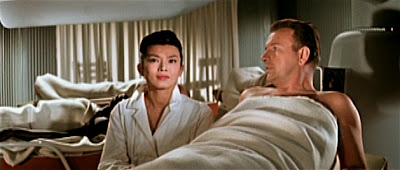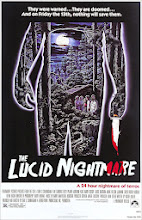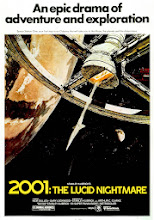Director: Kurt Maetzig
Year 1960
The Silent Star is a thought-provoking and eerie
The film begins with an alien spaceship being unearthed that contains a strange looking device scientists refer to as a memory spool. Contained within this artifact is a message that no linguist or cryptographer can decipher, yet they can determine the origin of this downed ship to be from the planet Venus. Being curious and impatient, an international crew is brought together in order to partake on a mission to the distant planet with a sole goal of making contact with this alien race, but without the translation of the memory spool they don’t know if they are going to arrive as friends or enemies to this race of beings. As they arrive on this strange new planet, the crew comes face to face with the shocking truth of the Venusians true intentions. Saturated in a mist of mysteries, The Silent Star delivers an outstanding story that is as equally entertaining as it is frightening.
The cast of The Silent Star is a cornucopia of international flavors deriving from all over the globe. The list goes on and on, but I’ll run through the main players that really stand out in this film. We’ve got Michail N. Postnikow taking on the role of the Soviet astronaut Prof. Arsenew, Gunther Simon playing the role of Raimund Brinkmann the German pilot, Yoko Tani playing the role of the Japanese doctor Sumiko Ogimura, Julius Ongewe taking on the role of Talua the African radio technician, and Oldrich Lukes filling in the boots of American atomic physicist Prof. Harringway Hawling. The entire cast does a wonderful job with their respective characters, but there are a few that go above and beyond their call of duty to make something exceptionally memorable about their individual roles.
Yoko Tani is one of these actors that really flesh out her character Sumiko. Her story is a sad one, as we find out that her husband has died on the moon prior to our introduction to her character and that she made it her sole purpose in life to continue her late husband’s research, thus landing her a seat on the mission to Venus. There is a very sad moment in the film where they fly past the moon and Yoko painfully recalls the horrific memory of her husband’s death. This is all done with acting and not flashbacks, so we get to see the horror of recollection flash across her face in vivid detail. Yoko does a great job in this scene and her character seems to have a great deal of emotional pull compared to the rest of the somewhat tepid cast.
Another stand out among the characters is Prof. Arsenew played by Michail N. Postnikow. He brings the dreamer aspect to his astronaut character, always looking to the stars in a positive light and hoping against hope that they find life that is both friendly and open to bridging the gap between the two races. Of all the characters in the movie, Michail’s Prof. Arsenew is the one that is most inline with the movie’s thematic arc. There is a great deal of positivity in the beginning half of the film, where the outlook on venturing into space is that of an optimistic light. Though the movie quickly begins to delve into a more dire tone, there is a great expression of love towards the expansion of man’s understanding of the universe, and this is felt the strongest in the character of Prof. Arsenew.
Aside from the various characters that inhabit this strangely engaging piece of science fiction fare, there is a great deal of attention put into the look and feel of the planet Venus. The landscape is surreally realized as it’s covered in a thick hazy fog that radiates across the screen and often begins to plunge into psychedelic territory with its bright colors and trippy visuals. The dreamlike quality that the filmmakers were able to accomplish with the look of the planet Venus is absolutely outstanding, making you feel like you’ve walked into a dreamscape of sorts with its totally unfamiliar presentation and haunting tone. One of the main accomplishments of this film is being able to depict such a strange world by use of traditional and practical effects. The miniature work and set designs for this film are some of the most inventive that I’ve run across during this time period of filmmaking. The Silent Star really does throw out all the tricks in the book to enable themselves to fully create a world that truly only exists on the silver screen.
This painstakingly robust design style runs over into the exterior and interior shots of the Venusian’s architecture, as we get to see what their command center looks like and a few of their cityscapes, even if that is after a nuclear fallout. There is a great deal of history that the filmmakers infuse into their set design, and the images that surround our brave crew often tell the story of what occurred in the Venusians past and what kind of society they lived in. This kind of attention to detail is greatly appreciated and you can tell that the filmmakers were as caught up in the story that they were telling as much as they hoped the audience eventually would when they finally got to see it for themselves. Overall, what was most impressive about The Silent Star was that it had a whole lot to say about our own society and that even though the population of Earth was in harmony for the most part in this film, the Venusians paralleled what the Earth was really like culturally speaking and I enjoyed the cautionary tale that the filmmakers where trying to get across. In the end, The Silent Star is a wonderful little science fiction story that really should be more known to genre fans around the world. This stuff is great!
Speaking of the look of the film, it is simply spellbinding in its depiction of the alien planet Venus. Super-charged with a surreal palette that looks like something from out of a dream, The Silent Star is anything but typical. Add onto that the inclusion of a stellar international cast and you have the recipe for one entertaining and thought-provoking film that takes a visionary look into interplanetary relations and pushes it into uncharted territories. If you like your science fiction films to have a more cerebral outlook on life then check this one out as soon as you can. They don’t make them like this anymore and that’s a damn shame. The Silent Star is a…..
 |
| How did I get duped into buying this stupid hat? |
 |
| Before I answer any of your questions, I'm well aware of my bird-like features. |
 |
| What a romantic day for a one on one poetry reading. |
 |
| So I'm ready for that happy ending now. |
 |
| People let's try to focus more on the mission and less on my freaking bird face. |
 |
| Get down from there you knucklehead. |
 |
| How come Brinkmann got a happy ending and I didn't get shit! |
 |
| I'm still waiting on that happy ending. I know you hear me! |
 |
| I'm going to kill the fool who designed these things. What's with the monkey ears? |
 |
| Find anything yet? We ain't find SHIT! |
 |
| So what are you nerds up to? |
 |
| Hey Darth Maul! Quite screwing around with that double-bladed light saber! |
 |
| Welcome to the Bog of Eternal Stench. |
 |
| I'm sorry to say that the mission was a failure. I still have my creepy bird-like features. |






























































































Great review and I love the captions on the still shots.
ReplyDeleteThanks Rico! Glad you enjoyed the review and the captions. It's funny because I've recently been told by a few people that the captions are the only thing that they don't like about the site. Good to know that someone out there is appreciating them. Thanks for taking the time to check out the review!
ReplyDeleteI saw this film at about age 10 in approximately 1965. It made such an impression on my that it probably made me the Science Fiction fan that I still am. Rediscovering it today (I had not known the title) was fantastic and a web search turned up your web page. Well done, I agree with your overall view that this is a very important piece of cinema. [But those subtitles, though amusing, might confuse anyone who has not seen the movie!] One thing that you didn't comment on was the spaceship interiors, which were very original in concept and - it seems to me - may have been very influential on later sci-fi works.
ReplyDelete